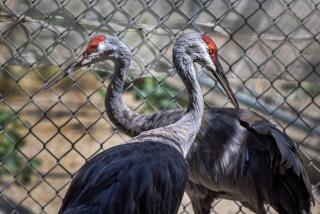Just Like People, Condors Flock to the Grand Canyon
- Share via
GRAND CANYON NATIONAL PARK, Ariz. — The South Rim of the Grand Canyon has long been a favorite of human visitors gawking at the stunning views and taking advantage of the man-made services.
As it turns out, the South Rim also is a favorite of endangered California condors -- for many of the same reasons.
The large birds often gather there to watch people, socialize with one another and drink from a leaky water pipe.
On some days, as many as 25 to 30 condors soar over the canyon area -- more birds than were in existence a generation ago when officials decided to capture and breed them.
The birds, which have dull orange featherless heads with a stubby beak and dark body feathers, were reintroduced in the wild in Arizona in 1996. What began with the release of six birds 50 miles north of here has led to a flock of 53, including some of the first wild-born condors since the early 1980s.
Two of the three fledglings hatched in Arizona have survived, and three other condor pairs are nesting this year, said Chris Parish, the Peregrine Fund’s condor director in Arizona. The nonprofit fund runs a breeding facility in Boise, Idaho, where the birds are hatched and prepared for release, and has overseen Arizona’s condor program.
He and others say it’s too early to call the reintroduction a success because the population isn’t self-sustaining yet.
“But we finally have a foothold,” he said. “I, for one, have confidence ... we’re well on our way.”
California condors are among the largest birds native to North America and have no natural predators. With a wingspan of up to 9 1/2 feet, they have a reach 2 feet wider than NBA giant Yao Ming.
The condors, which may live up to 60 years, were driven to near extinction by the early 1980s. Shootings, poisonings and collisions with power lines, combined with their naturally low reproductive rate, shriveled the birds’ population.
To keep them from disappearing, federal officials and nonprofit groups worked to capture the birds and breed them with hopes that they could be released into the wild again.
Releases began in 1992 in California. Today, there are about 118 birds in the wild in Arizona, central and Southern California, and coastal Mexico.
Jesse Grantham, condor recovery program coordinator for the U.S. Fish and Wildlife Service, said the 25-year project to save the condors has taught biologists along the way.
The early years of reintroduction were difficult because the young birds didn’t have older birds to follow in the wild. Biologists didn’t anticipate that the young condors would need mentors, but it makes sense in hindsight, he said.
Now that older birds have established patterns in the wild, it has become safer for younger birds to follow.
People in the region have also adapted to the return of the wild birds.
Some residents of northern Arizona and southern Utah were concerned when the reintroduction began. They feared that the endangered birds would bring federal intrusion and restrictions, Parish said.
But now, the locals are accustomed to the birds. And canyon visitors, who hardly noticed the condors at first, love them.
At least one South Rim gift shop sells condor plush toys and T-shirts bearing the condor image. Park officials hold daily, sometimes twice daily, interpretive programs for visitors about the condors right over the South Rim location that the birds use as their social hub, said Chad Olson, the canyon’s raptor biologist.
“It’s such a unique situation where you can show people one of the most endangered species in the world,” he said.
The park is a blessing and curse for the condors, he said. It’s protected and has millions of acres of habitat for the birds, which have a home-range radius of 50 to 70 miles.
But there are a lot of people here, and biologists fear that the condors will come to think that people are safe.
“There are some challenges we deal with, primarily people management more than bird management,” said Olson, who sometimes waves his arms to scare the birds if they come too close to the crowds gathered on the rim.
But the canyon’s rim is attractive to the birds, in part because there is so much activity and because they are so curious, he said.
“It’s such a crazy unnatural situation where you have this insane amount of activity,” Olson said. “They innately know the places to find food is where there’s activity.”
The condors, although raised in captivity by people using bird-shaped puppets to feed them, are also perhaps drawn to the Grand Canyon by instinct.
Olson rappelled to a nesting cave that a pair of condors tried unsuccessfully to use to mate in 2002 and 2003. The biologists couldn’t figure out why the birds failed, but they did find bones in the cave.
It turned out that the bones were those of condors and condor prey some 10,000 to 15,000 years old.
The recent successful breedings prove that the species has a future despite its near disappearance, Olson and Parish said.
“They’re certainly not a relic species,” Olson said. “They declined because of us.”
Still, officials expect to be managing the birds for a long time -- if not indefinitely.
It would take three flocks of about 150 birds each and 15 breeding pairs before the birds could be considered for downgrading on the endangered species list, Olson said.
“We still have a ways to go,” he said.
More to Read
Sign up for Essential California
The most important California stories and recommendations in your inbox every morning.
You may occasionally receive promotional content from the Los Angeles Times.













